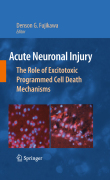
Acute neuronal injury: the role of excitotoxic programmed cell death mechanisms
Fujikawa, Denson G.
The purpose of this book is to present clinically relevant basic mechanisms of excitotoxic neuronal death, which in the adult mammalian brain is morphologically necrotic, not apoptotic, and which involve caspase-independent mechanisms of programmed cell death. The spectrum of clinically relevant pathologicallyinduced excitotoxic neuronal death includes cerebral ischemia, traumatic brain injury, cerebral hypoglycemia, and status epilepticus. By investigating mechanisms, potential neuroprotective strategies can be identified that may have future clinical application. INDICE: Introduction: Programmed mechanisms and the clinical spectrum of excitotoxic neuronal death; D.G. Fujikawa.- Part 1: Caspase-independent programmed cell death: general considerations. 1: Caspase-independent cell death mechanisms in simple animal models; M. Rieckher, N. Tavernarakis. 2: Programmed necrosis: a 'new' cell death outcome for injured adult neurons?; S. Krantic, S.A. Susin. 3: Age-dependence of neuronal apoptosis and of caspase activation; D.G. Fujikawa. 4: Excitotoxic programmed cell death involves caspase-independent mechanisms; Ho Chul Kang, T.M. Dawson, V.L. Dawson.- Part 2: Focal Cerebral ischemia. 5: Apoptosis-inducing factor translocation to nuclei in focal cerebral ischemia; C. Culmsee, N. Plesnila. 6: The role of poly(ADP-ribose) polymerase-1 (PARP-1) activation in focal cerebral ischemia; G. Faraco, A. Chiarugi.- Part 3: Transient Global Ischemia. 7: Transient global cerebral ischemia produces necrotic, not apoptotic neurons; F. Colbourne, R. Auer. 8: Apoptosis-inducing factor translocation to nuclei after transient global ischemia; Can Liu, A.P. Signore, Guodong Cao, Jun Chen. 9: Role of µ-calpain I and lysosomal cathepsins in hippocampal neuronal necrosis after transient global ischemia in primates; A.B. Tonchev, T. Yamashima.- Part 4: Traumatic central nervous system; CNS) injury. 10: Mitochondrial damage in traumatic CNS injury; L.M. Davis, P.G.Sullivan. 11: Programmed mechanisms in traumatic CNS injury; B.A. Stoica, A.I. Faden.- Part 5: Hypoglycemic neuronal death. 12: Hypoglycemic neuronal death: morphological considerations; tentative title pending receipt of manuscript;R. Auer. 13: The role of poly(ADP-ribose) polymerase-1 (PARP-1) in hypoglycemic neuronal death; tentative title pending receipt of manuscript; Sang Won Suh, R.A. Swanson.- Part 6: Seizure-induced neuronal death. 14: p53 activation isnecessary in seizure-induced neuronal death; Zhiquin Tan, S.S. Schreiber. 15:DNA damage and repair in the brain: implications for seizure-induced neuronalinjury, endangerment, and neuroprotection; S.L. Crowe, A.D. Kondratyev. 16: Activation of caspase-independent programmed pathways in seizure-induced neuronal necrosis; D.G. Fujikawa.- Concluding Remarks; D.G. Fujikawa.
- ISBN: 978-0-387-73225-1
- Editorial: Springer
- Encuadernacion: Cartoné
- Páginas: 350
- Fecha Publicación: 01/11/2009
- Nº Volúmenes: 1
- Idioma: Inglés
